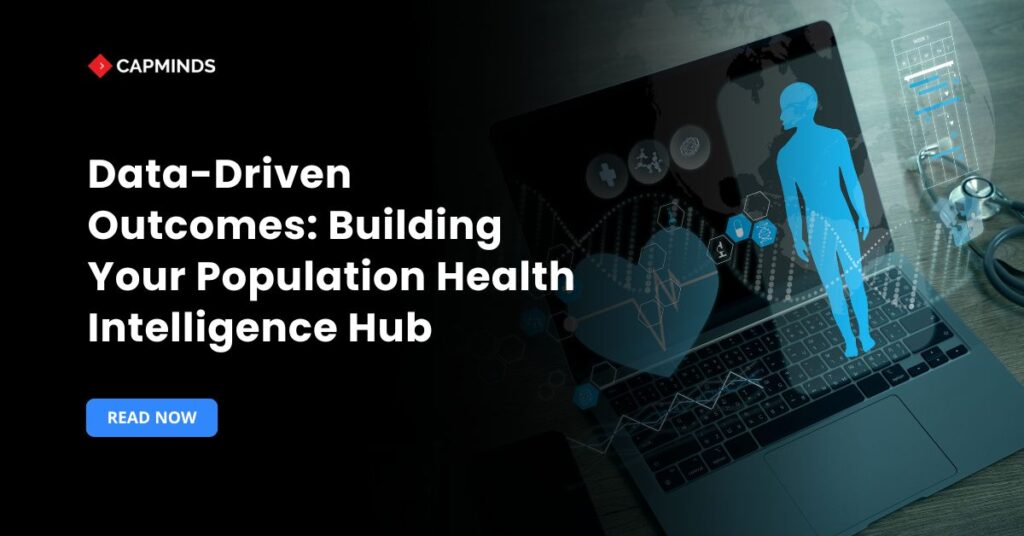Data-Driven Outcomes: Building Your Population Health Intelligence Hub
Modern healthcare increasingly depends on turning data into actionable insight. By aggregating and analyzing diverse health data, organizations can better understand the needs of patient populations, target interventions, and measure outcomes. A data-driven population health approach – often supported by a centralized “intelligence hub” – is now recognized as essential to achieving the Triple Aim of care: improving population health and the patient experience while reducing cost growth.
In practice, this means moving beyond siloed clinical and financial systems toward a unified analytics platform that continuously learns from data across settings. Health systems that embrace these modern capabilities uncover hidden trends and inefficiencies – for example, identifying high-risk groups or underused services – and can proactively redesign care.
Building such an intelligence hub enables stakeholders to holistically manage population health. As one expert review notes, population health management “targets interventions based on specific population needs” and is fundamentally a data-driven strategy.
Coordinated data and analytics are needed to support this vision, essentially creating a “learning health system” that captures insights from past events and anticipates future needs. The return on investing in these data capabilities is tangible: published reports show comprehensive population health programs often yield a positive ROI by reducing avoidable hospital use and improving care.
What Is a Population Health Intelligence Hub?
A population health intelligence hub is a centralized data platform that aggregates and organizes information from across the healthcare ecosystem. Rather than operating with fragmented silos of clinical, financial, and social data, a hub serves as a single source of truth for analytics.
- In practice, it will collect and link data from electronic health records, insurance and pharmacy claims, laboratory systems, patient registries, and patient-generated sources.
- It also incorporates non-medical data, such as social determinants of health or community resources, to create a 360-degree view of patient needs.
For example, experts describe how leading population health initiatives are built by “leveraging data from electronic health records, insurance claims, and public health data systems” to inform care strategies and decision-making. By centralizing these diverse streams, the hub enables advanced analytics that are simply not possible in disconnected systems.
In essence, the intelligence hub is the analytic engine for population health. It can be thought of as a secure data repository or “data warehouse” designed for health analytics: a place where clinical metrics, utilization records, and socioeconomic data are integrated and prepared for analysis.
A centralized repository like this allows health leaders to identify trends, measure quality, and coordinate care across settings. Studies emphasize that integrated data platforms can dramatically improve decision-making, for example, one guide notes that data repositories enable “informed decision-making and driving improvements in public health”.
Integrating Diverse Data for Actionable Insights
A critical advantage of the population health hub is its ability to combine diverse data sources in one place. Each data type adds a piece to the puzzle of population needs:
1. Clinical EHR Data
Electronic health records capture diagnoses, clinical measurements, lab results, medications, and encounter histories. This core clinical data identifies patients with chronic conditions, preventive care gaps, and treatment outcomes. When pooled across all providers in a region or network, EHR data enable analytics on trends such as hospital readmissions or community disease prevalence.
2. Claims and Financial Data
Insurance claims and billing data add the payer’s perspective: utilization patterns, cost of services, and care settings. Linking claims with EHR records helps reveal the cost of care for identified patient cohorts. For example, combining claims-driven cost data with clinical risk stratification enables organizations to pinpoint which high-need patients are driving excessive costs, and then measure whether interventions (like intensive care management) reduce expenditures.
3. Social Determinants of Health
Non-clinical factors – housing stability, food access, employment, transportation, education, and more- profoundly affect health outcomes. Clinicians and policymakers increasingly recognize that medical care accounts for only ~20% of health outcomes, while social and environmental factors account for roughly 80%. Capturing SDOH data gives a holistic view of patient needs.
4. Patient-Generated and Remote Monitoring Data
Increasingly, patients generate health data through wearables, home monitoring devices, or smartphone apps. When a population health hub ingests these real-time signals, care teams can monitor chronic conditions and recovery progress more continuously.
- For example, alerts from remote monitors can trigger earlier outreach to a rising-risk patient, while wearable data can inform wellness coaching programs.
- Although incorporating such data requires attention to standards and privacy, it is a growing source of actionable insight in population health strategies.
By unifying these sources, the hub produces actionable insights that no single system could provide alone. For instance, linking EHR and claims data reveals which high-utilizers have unaddressed clinical needs; adding SDOH can show why certain groups aren’t accessing care; and overlaying resource utilization highlights areas where better care coordination could reduce waste.
Related: Building Fitness & Wellness Apps for Population Health: What Large Providers Should Know
Impact on Clinical, Operational, and Financial Outcomes
A well-designed intelligence hub delivers benefits across the spectrum of healthcare goals:
1. Clinical Outcomes
Data-driven population health programs consistently show better patient outcomes.
By using predictive models to identify high-risk individuals and intervening early, organizations have reported significant improvements in key clinical metrics.
- For example, comprehensive population health initiatives have achieved ~15–20% reductions in 30-day hospital readmission rates and noticeable gains in chronic disease control.
- Preventive care also improves: screening rates for cancers and chronic conditions typically rise by double digits after systematic outreach powered by analytics.
- Medication adherence tends to improve as well when nonadherence flags from data prompt pharmacist review or patient coaching.
In essence, the hub enables a learning environment where interventions can be tailored, tested, and refined, leading to measurable improvements in population health over time.
2. Operational Efficiency
Integrating data reduces wasteful processes and streamlines care delivery. When care teams have clear analytics showing which patients need outreach, they waste less time on manual chart reviews and administrative tasks. Workflows become more standardized: for example, risk stratification algorithms automatically flag patients with care gaps, so staff can focus on intervention rather than data searching.
Reports show that population health practices using advanced analytics can “streamline workflows” and “reduce administrative burden” significantly.
Staffing can be aligned to true need – e.g., more care managers in areas with more high-risk patients – improving productivity. In sum, a centralized hub turns disparate systems into a coordinated operation, raising efficiency and often freeing up clinician time for direct care.
3. Financial Outcomes
More efficient and effective care yields cost savings. By managing chronic disease proactively, organizations see fewer avoidable emergency department visits and hospitalizations – real dollars saved.
- Case studies report ED utilization drops on the order of 15–25% when high-risk patients are closely managed by population health teams.
- Coordinated care also cuts duplicative testing and unnecessary procedures.
- Pharmacist-led medication reviews and formulary optimization can lower pharmacy costs by 5–10%.
- Altogether, systems practicing mature population health methods often see 3–5% reductions in total cost of care compared to peers.
These savings translate into better financial performance under value-based payment models. Moreover, the investment in analytics platforms itself pays off: studies find that comprehensive PHM programs can return $2–$4 for each $1 spent.
Key Considerations for Implementation
Deploying a population health intelligence hub is a major initiative that requires careful planning. The following considerations are critical for success:
1. Data Strategy and Integration
Ensure a robust architecture for ingesting and linking data. This means using standard formats to harmonize disparate sources. Consolidation often involves extract/transform/load processes, master patient indexing, and data mapping to a common data model.
Plan for connecting all relevant sources: EHR systems, claims databases, pharmacy systems, SDOH repositories, public health registries, and even patient devices or mobile apps.
Leverage secure APIs or data feeds to automate updates. Establish a centralized data warehouse or data lake that can scale as data volume grows. Importantly, build in data quality controls: validation, de-duplication, and normalization steps help ensure the analytics outputs are trustworthy.
2. Interoperability and Standards
Technical interoperability is a must. The hub should support industry standards so that data can flow in from any partner. Work with regional health information exchanges or data collaboratives, where possible, to streamline integration. As one analyst notes, aligning data exchange standards across entities is crucial to “ensure data consistency, accuracy, and transparency,”.
The goal is seamless sharing of information – patients should have a continuous record even if they move between clinics, hospitals, and community services. Using open APIs and industry-standard interfaces will prevent getting locked into any one vendor and future-proof the investment.
3. Security, Privacy, and Governance
A population health hub contains highly sensitive information, so strong protections are imperative. Implement robust security measures to guard against breaches. All data handling must comply with HIPAA and other regulations.
Equally important is establishing governance policies: decide who can access what data, for what purposes, and how consent is managed. Effective governance frameworks will also clarify data ownership and stewardship across participating organizations.
Building trust among data contributors and with patients is essential; governance policies should address data use cases clearly and be transparent about the benefits to care quality and equity.
4. Clinical and Operational Workflow Alignment
The best analytics are useless if they don’t fit into workflows. Engage clinical and operational leaders early to define how insights from the hub will be used.
- For example, risk scores should be integrated into care team workflows so staff can act on them.
- Establish interdisciplinary teams that include IT, clinicians, care coordinators, and finance, mirroring the cross-functional collaboration needed for success.
- Training programs will be needed so that staff trust and understand the new tools.
Adopt a learning approach: start with pilot projects or specific use cases, measure results, and iterate. Formal governance bodies can help coordinate across departments and keep the program on track.
5. Scalability and Future-Proofing
Design the hub with growth in mind. Healthcare data volumes are large and growing, especially with new modalities. Choose a technology platform that can scale storage and computing power.
Ensure the architecture can incorporate new data types in the future. This flexibility will help sustain long-term value from the hub.
6. Change Management and Culture
Implementing an intelligence hub is as much about people as technology. Leadership must articulate a clear vision for why data-driven population health is a priority. Clinicians and staff should be engaged around the promise of better care, for example, showing how risk-stratification data can help them focus on patients who need them most. Celebrate early wins to build momentum.
Emphasize transparency and a “learning culture”: use the hub as a tool for continuous improvement rather than punitive oversight. When stakeholders see positive outcomes, like patient benefit or efficiency gains, it will reinforce support for the initiative.
7. Measurement and Governance
Define key performance indicators tied to your goals and use the hub to track them over time. Ongoing analytics should evaluate program effectiveness and ROI, guiding resource allocation. Establish a governance process to review these metrics and adapt strategies. Because PHM is iterative, regular evaluation loops are necessary to refine algorithms and interventions.
8. Partnerships and Collaboration
Building a robust hub often involves partnerships beyond a single organization. Consider collaborations with other providers, payers, public health entities, or community groups. Data sharing agreements and consortium models can enlarge the hub’s data universe and impact.
For example, working with public health departments or social service agencies can bring in population-level SDOH datasets that no single provider holds. Such collaborations must balance data sharing with legal and competitive considerations, but they can greatly amplify the hub’s value in improving community health.
Each of these considerations requires investment in governance structures, technology, and human capital. But when done right, they set the stage for a sustainable, scalable analytics program.
Organizations should plan carefully, perhaps phasing the project, while constantly engaging stakeholders. As noted in industry analyses, success ultimately hinges on “a more strategic approach to data solutions” that specifies the role of data at each task. In other words, the technology must be matched with a strategy for care delivery change.
Build Your Population Health Intelligence Hub with CapMinds Technology Expertise
At CapMinds, we help healthcare organizations unlock the full potential of their data through tailored, end-to-end digital health solutions.
Whether you’re just starting your population health journey or ready to scale, our team brings the expertise, tools, and strategic support to make it happen.
Here’s how we can support your vision:
- Custom-built analytics platforms for cohort stratification, care gap analysis, and SDOH integration
- Seamlessly connect data sources across systems, care settings, and stakeholders
- Centralized, secure repositories optimized for population-level insights
- Actionable intelligence for clinical, operational, and financial decision-making
- Built-in data privacy, HIPAA security, and scalable architecture
Let’s turn your data into measurable outcomes.
👉 Talk to our experts today and start building your intelligence hub.




